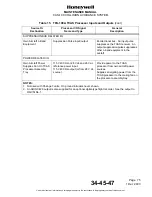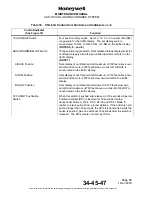
Page 82
1 Dec 2003
34-45-4
7
MAINTENANCE MANUAL
CAS-100 COLLISION AVOIDANCE SYSTEM
Use or disclosure of information on this page is subject to the restrictions in the proprietary notice of this document.
7. Controls and Indicators
A. General
The primary manual controls used to operate the CAS-100 system are contained on the
transponder/TCAS control units.
NOTE:
TCAS advisory and/or serviceable status indications are given on the TA/VSI, RA/VSI,
PPI, dedicated traffic display, cockpit audio system, transponder/TCAS control unit,
front panel of the TCAS processor, and front panel of the Mode S transponder unit.
It is possible to supply the control of traffic advisory display range selection at a distance from
the transponder/TCAS control unit or locally through a front panel range selector switch or
switches. The control is supplied depending upon type of display unit used and display unit
configuration strapping.
B. TCAS Input Power Control
115 V 400 Hz or 28 V dc primary power, 26 V ac reference power, and 5 V ac or dc or 28 V dc
background panel lighting power are applied to TCAS by closing aircraft circuit breakers.
TCAS does not contain a power on/off switch or fuses.
C. CTA-81( ) Control Unit
See Figures 10 and 11. The CTA-81( ) Control Unit is the primary control for both TCAS and
the transponder. The CTA-81A Control Unit is used in the installations containing two
TRA-67A Mode S transponders. The CTA-81B is used in the installations containing one
TRA-67A Mode S transponder and one ATCRBS transponder. The Tables 18 and 19 give the
functions of the controls and indicators on the control units.
D. CTA-100A Control Unit
See Figure 12. The CTA-100A is an upgraded and enhanced microprocessor-based
transponder control panel for controlling maximum two TRA-67A ATC transponders and the
TPA-81A/TPA-100A TCAS processors. The CTA-100A controller is supplied with two basic
front panel configurations, a rotary control version and a keypad entry version. The CTA-100A
can facilitate the front panel interchangeability. It is made in all functional configurations of the
CTA-81( ) control panels with the same connector configuration and is applicable for a
one-for-one component change-out. The Table 20 gives the functions of the controls and
indicators on the control unit.
















































